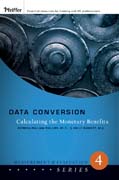
Data conversion: calculating the monetary benefits
Phillips, Jack J.
Phillips, Patricia Pullian
This book tackles the third major challenge and the second most difficult step in the ROI methodology: converting data to monetary values. When a particular project or program is connected to a business measure, the next logical question is: what is the monetary value of that impact? For ROI analysis, it is atthis critical point where the monetary benefits are developed to compare to the costs of the program to calculate the ROI. Includes: the importance of converting data to monetary value; preliminary issues; standard values: the standard values: where to find them; using internal experts, using external databases; linking with other measures; using estimates; when to abandon conversion efforts and leave data as intangible, analyzing the intangibles; and reporting the intangibles. INDICE: Acknowledgments. Principles of the ROI Methodology. 1. The Importance of Converting Data to Monetary Values. Why Convert Data to Monetary Values? Value Equals Money. Impact Is More Understandable. Programs Start Because ofMoney. Converting Data to Money Is Similar to Budgeting. Monetary Value Is Vital to Organizational Operations. Monetary Values Are Necessary to Understand Problems. Hard and Soft Data. Converting Data to Monetary Values. 1. Focus on a Unit of Measure. 2. Determine the Value of Each Unit. 3. Calculate the Change in Performance Data. 4. Determine the Annual Amount of Change. 5. Calculate the Total Value of the Improvement. Case Example of Converting Data to Monetary Values. Final Thoughts. 2. Use Standard Values. Converting Output Data to Monetary Values. Case Example: A Commercial Bank. Case Example: Snapper Lawn Mowers. More Examples of Standard Values for Output Measures. Converting Quality to Monetary Value. Quality Cost Categories. Examples of Quality Cost Evaluations. Converting Employee Time to Monetary Value. Case Example: A Technology Company. Caution. Why Standard Values Are Developed. Standard Values Are Everywhere. Final Thoughts. 3. Calculate the Value. Using Historical Costs. Key Issuesin Using Records and Reports. Case Study: A Metropolitan Transit Authority. Linking with Other Measures. Classic Relationships. Case Example: A European Postal Service. Case Example: Sears, Roebuck and Company. Concerns When Using Relationships Between Measures to Assign Monetary Values. Final Thoughts. 4. Find the Value. Using Internal and External Experts. Working with Internal Experts. Working with External Experts. Case Example: A Manufacturing Plant. Case Example: A Health Care Firm. Using External Databases. Internet Searches. Case Example: A Regional Bank. Case Example: A Federal Agency. Other Sources of Databases. Final Thoughts. 5. Estimate the Value. Using Estimates from Participants. Case Example: A Manufacturing Plant. Key Issues in Using Participant Estimates. Using Estimates from Supervisors and Managers. Using Estimates from Senior Management. Using Staff Estimates. Final Thoughts. 6. Use of Data ConversionTechniques. Selecting the Appropriate Technique. Ensuring the Accuracy and Credibility of Data. Credibility: The Key Issue. How the Credibility of Data Is Influenced. Rules for Determining Credibility. Pager: Please style the following items as a sublist to the previous item. Reputation of the Source of the Data. Reputation of the Source of the Study. Motives of the Evaluators. AudienceBias. Methodology of the Study. Assumptions Made During the Analysis. Realismof the Outcome Data. Type of Data. Scope of Analysis. Pager: End of sublist. How to Address the Issue of Credibility. Pager: Please style the following items as a sublist to the previous item. Use the Most Credible and Reliable Sources for Estimates. Remain Unbiased and Objective. Prepare for Potential Audience Bias. Fully Explain Your Methodology at Each Step in the Process. Define Assumptions Made During the Analysis. Prepare for an Unrealistic Value. Use Hard Data Whenever Possible. Keep the Scope of Analysis Narrow. Pager: End of sublist. Making Adjustments. Consider the Possibility of Management Adjustment. Consider the Issue of Short-Term Versus Long-Term Programs. Consider an Adjustment for the Time Value of Money. Converting Data to Money: Matching Exercise. Final Thoughts. 7. Intangible Measures. Why Intangibles Are Important. Intangibles Are the Invisible Advantage. We Are Entering the Intangible Economy. Intangibles Are Being Converted to Tangibles. Intangibles Drive Programs. Measuring Intangibles. Converting Intangibles to Monetary Values. Identifying and Collecting Intangibles. Analyzing Intangibles. Confronting Intangibles. Example 1: Customer Service. Example 2: Innovation and Creativity. Innovation. Creativity.Example 3: Employee Attitudes. Employee Satisfaction. Organizational Commitment. Employee Engagement. Example 4: Leadership. 360? Feedback. Leadership Inventories. Leadership Perception. Business Impact. Final Thoughts. About the Authors. Index.
- ISBN: 978-0-7879-8720-6
- Editorial: Jossey Bass
- Encuadernacion: Rústica
- Páginas: 160
- Fecha Publicación: 20/02/2008
- Nº Volúmenes: 1
- Idioma: Inglés
